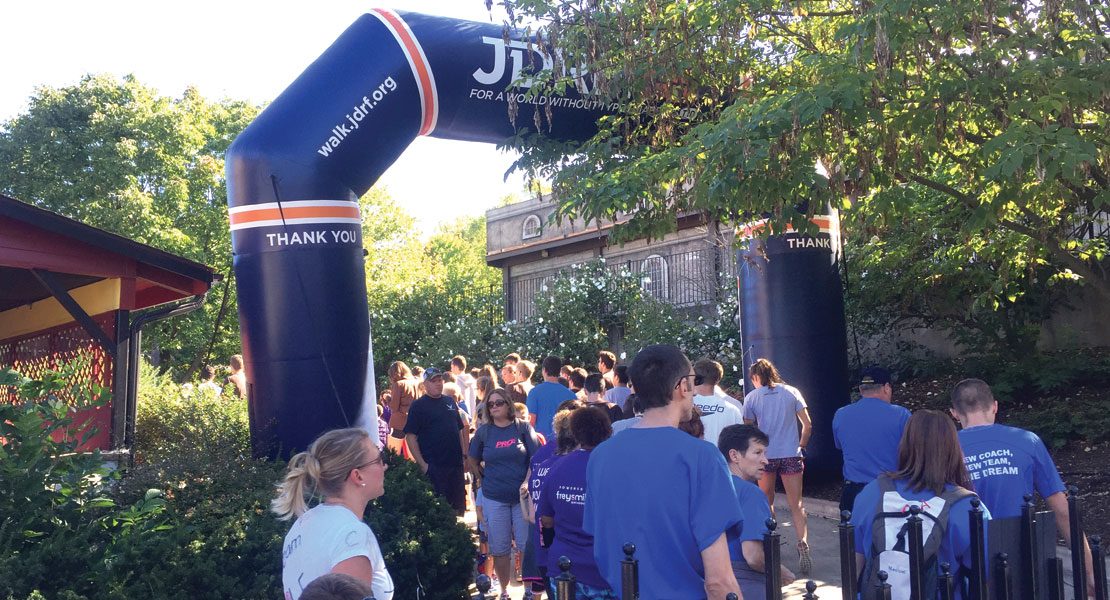Juvenile Diabetes Research Foundation

What’s the first thing your 10-year-old does when she wakes up? Sleepily reach for her phone—already over her data usage a week into the month—and scan through her notifications? Put on her Beats® and binge watch her latest Netflix® obsession? Announce how bored she is, an affliction that mysteriously vanishes at the mention of chores?
Ever since Lily Scott was 10, the first thing she has done every morning is check her blood sugar. She does it again before each meal and once more before she goes to bed. Prior to eating a meal—even grabbing a snack as she heads out the door—Lily has to calculate the amount of carbohydrates she is about to consume. Lily isn’t on a diet—she has to use that number to decide how much insulin she needs to give herself in order to avoid potentially life-threatening complications. You see, Lily is one of 1.25 million Americans living with type 1 diabetes in the United States. Every day, this is their routine.
Now an adult, Lily works as the senior development coordinator at the Eastern Pennsylvania chapter of JDRF, the Juvenile Diabetes Research Foundation. The nonprofit was founded in Philadelphia in 1970 by a group of parents who were overwhelmed with their children’s type 1 diabetes diagnoses and underwhelmed by the medical options available. Today, it has expanded across all 50 states, with 96 chapters and even six international affiliates. Originally created to support juvenile diabetes, the organization now focuses on people with type 1 diabetes of all ages. Since 1970, JDRF has contributed more than 2 billion dollars to research.
“Our mission is to reduce the impact that type 1 diabetes has on people’s lives,” Lily says. “Our ultimate goal is to rid the world of the disease entirely.”
Type 1 diabetes is an autoimmune disease that causes the pancreas to be unable to create insulin, a vital hormone that converts sugar into energy. Without this hormone, sugar accumulates in the bloodstream and can reach dangerous levels. Unlike type 2 diabetes, type 1 diabetes cannot be prevented or reversed. There is no amount of exercise and there is no special diet that can cure type 1.
Diabetes is the leading cause of blindness and kidney failure, and continues to be a high risk factor for heart disease, stroke, and foot and leg amputations. It is currently a lifelong condition that has to be managed every day to avoid life-threatening consequences—even the act of enjoying a slice of pizza can require significant planning around insulin doses in order to avoid high blood sugar and diabetic complications.
“Even when you’re on vacation or it’s your wedding day, you still have to check your blood sugar,” Lily says. “You can’t just leave the house; you can’t just go away for the night. You have to make sure you have your supplies, make sure you have your emergency glucose, and pack extra insulin in case you drop a vial and it breaks. Your brain is always on diabetes mode.”
Thanks to new research and technology, however, the quality of life for people with type 1 diabetes has improved. Lynne Kirshner, who has volunteered at JDRF for more than 30 years, recalls having to squeeze her baby’s diapers for urine to test his blood sugar every day. Times have changed: insulin pumps that used to be the size of large backpacks now fit in pockets, and the invention of continuous glucose monitors provide a steady and reliable stream of vital information.
One of the latest breakthroughs includes the Artificial Pancreas Project, which is in its final stage of human clinical trials. JDRF has invested more than 1 million dollars in the project, which will close the loop between the continuous glucose monitor and the insulin pump to accurately and effectively release insulin into the body the way a regularly functioning pancreas does.
Another promising treatment option that is being researched is known as the Encapsulation Project, a small implant that will allow people with type 1 diabetes to achieve normalized blood-glucose control for up to five years or longer.
Finally, JDRF is heavily invested in the Restoration Project. Still in early phases of development, the promising project aims to restore the body’s ability to create insulin-producing cells and prevent the immune system from attacking and destroying the cells. The result will leave the bodies of those with type 1 diabetes able to do what it was biologically intended to do, making the disease reversible.
“We are able to see the light at the end of the tunnel and we’re on the brink of so many things,” Lily says. “It’s happening. It’s finally happening.”
One way JDRF is able to contribute to advances in research is through its event-based fundraising. The nonprofit organizes six annual walks, with one coming up on September 25 at Dorney Park. Two thousand attendees are expected to band together from all walks of life for a 3 mile walk in solidarity. Last year, the walk raised more than $80 thousand dollars, and the organization hopes to surpass that amount this year.
For more information about type 1 diabetes or JDRF, visit jdrf.org.
JDRF One Walk®
Date: September 25
Check-in: 9:00 a.m.
Start: 10:00 a.m.
Where:
Dorney Park
3830 Dorney Park Road
Allentown, PA 18104
Walk Length: 3 miles
Contact:
Maggie Bonge
610.227.0369
mbonge@jdrf.org













